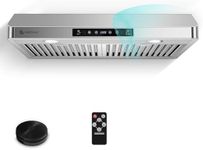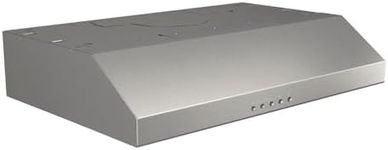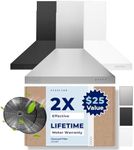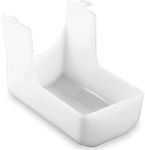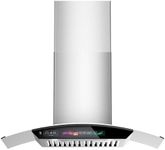Buying Guide for the Best Extractor Hoods
Choosing the right extractor hood for your kitchen is essential for maintaining a clean and odor-free cooking environment. Extractor hoods come in various styles and with different features, so it's important to understand what each specification means and how it can impact your cooking experience. Here are some key specifications to consider when selecting an extractor hood that best fits your needs.Extraction RateThe extraction rate, measured in cubic meters per hour (m³/h), indicates how much air the hood can extract in an hour. This is important because a higher extraction rate means the hood can remove more cooking odors, smoke, and grease from the air. For small kitchens, an extraction rate of 300-500 m³/h may be sufficient, while larger kitchens or those with heavy cooking needs might require a rate of 500-900 m³/h or more. Consider the size of your kitchen and your cooking habits to determine the right extraction rate for you.
Noise LevelThe noise level of an extractor hood is measured in decibels (dB) and indicates how loud the hood will be when in operation. This is important because a quieter hood can make your kitchen a more pleasant place to be, especially if you spend a lot of time cooking. Noise levels typically range from 40 dB (quiet) to 70 dB (loud). If you prefer a quieter kitchen, look for models with noise levels below 60 dB. Consider how sensitive you are to noise and how much time you spend in the kitchen when choosing the right noise level.
Type of HoodExtractor hoods come in various types, including wall-mounted, island, under-cabinet, and integrated hoods. The type of hood you choose will depend on your kitchen layout and personal preference. Wall-mounted hoods are great for kitchens with a clear wall space above the stove, while island hoods are designed for cooktops located on kitchen islands. Under-cabinet hoods fit beneath kitchen cabinets, and integrated hoods are built into the cabinetry for a seamless look. Consider your kitchen layout and aesthetic preferences when selecting the type of hood.
Filter TypeExtractor hoods use different types of filters to trap grease and odors. The most common types are metal grease filters and charcoal filters. Metal grease filters are reusable and can be cleaned in the dishwasher, making them a low-maintenance option. Charcoal filters, on the other hand, need to be replaced periodically and are used in recirculating hoods to remove odors. If you prefer low maintenance, opt for a hood with metal grease filters. If odor removal is a priority, consider a hood with charcoal filters.
Ducted vs. RecirculatingExtractor hoods can be either ducted or recirculating. Ducted hoods vent the air outside, which is effective for removing heat, moisture, and odors from the kitchen. Recirculating hoods filter the air and then release it back into the kitchen, which is easier to install and suitable for kitchens without external venting options. If you have the option to install ductwork, a ducted hood is generally more effective. If not, a recirculating hood can still provide good air filtration.
SizeThe size of the extractor hood should match the size of your cooktop to ensure effective extraction. Hoods typically come in widths ranging from 60 cm to 120 cm. A good rule of thumb is to choose a hood that is at least as wide as your cooktop, if not slightly wider. This ensures that the hood can capture all the steam and odors produced during cooking. Measure your cooktop and choose a hood that matches or exceeds its width for optimal performance.
LightingMany extractor hoods come with built-in lighting to illuminate your cooking area. This is important for visibility and safety while cooking. Look for hoods with LED lights, as they are energy-efficient and provide bright, clear light. Consider how much additional lighting you need in your kitchen and choose a hood with sufficient lighting to meet your needs.

